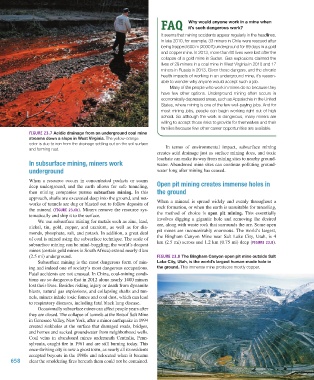Page 659 - Environment: The Science Behind the Stories
P. 659
FaQ Why would anyone work in a mine when
it’s such dangerous work?
It seems that mining accidents appear regularly in the headlines.
In late 2010, for example, 33 miners in Chile were rescued after
being trapped 600 m (2000 ft) underground for 69 days in a gold
and copper mine. In 2013, more than 60 lives were lost after the
collapse of a gold mine in Sudan. Gas explosions claimed the
lives of 29 miners in a coal mine in West Virginia in 2010 and 17
miners in Russia in 2013. Given these dangers, and the chronic
health impacts of working in an underground mine, it’s reason-
able to wonder why anyone would accept such a job.
Many of the people who work in mines do so because they
have few other options. Underground mining often occurs in
economically depressed areas, such as Appalachia in the United
States, where mining is one of the few well-paying jobs. And for
most mining jobs, people can begin working right out of high
school. So although the work is dangerous, many miners are
willing to accept those risks to provide for themselves and their
families because few other career opportunities are available.
Figure 23.7 Acidic drainage from an underground coal mine
streams down a slope in West Virginia. The yellow-orange
color is due to iron from the drainage settling out on the soil surface
and forming rust. In terms of environmental impact, subsurface mining
creates acid drainage just as surface mining does, and toxic
leachate can make its way from mining sites to nearby ground-
In subsurface mining, miners work water. Abandoned mine sites can continue polluting ground-
underground water long after mining has ceased.
When a resource occurs in concentrated pockets or seams
deep underground, and the earth allows for safe tunneling, Open pit mining creates immense holes in
then mining companies pursue subsurface mining. In this the ground
approach, shafts are excavated deep into the ground, and net-
works of tunnels are dug or blasted out to follow deposits of When a mineral is spread widely and evenly throughout a
the mineral (Figure 23.6b). Miners remove the resource sys- rock formation, or when the earth is unsuitable for tunneling,
tematically and ship it to the surface. the method of choice is open pit mining. This essentially
We use subsurface mining for metals such as zinc, lead, involves digging a gigantic hole and removing the desired
nickel, tin, gold, copper, and uranium, as well as for dia- ore, along with waste rock that surrounds the ore. Some open
monds, phosphate, salt, and potash. In addition, a great deal pit mines are inconceivably enormous. The world’s largest,
of coal is mined using the subsurface technique. The scale of the Bingham Canyon Mine near Salt Lake City, Utah, is 4
subsurface mining can be mind-boggling; the world’s deepest km (2.5 mi) across and 1.2 km (0.75 mi) deep (Figure 23.8).
mines (certain gold mines in South Africa) extend nearly 4 km
(2.5 mi) underground. Figure 23.8 The Bingham Canyon open pit mine outside Salt
Subsurface mining is the most dangerous form of min- Lake City, Utah, is the world’s largest human-made hole in
ing and indeed one of society’s most dangerous occupations. the ground. This immense mine produces mostly copper.
Fatal accidents are not unusual. In China, coal-mining condi-
tions are so dangerous that in 2012 alone nearly 1400 miners
lost their lives. Besides risking injury or death from dynamite
blasts, natural gas explosions, and collapsing shafts and tun-
nels, miners inhale toxic fumes and coal dust, which can lead
to respiratory diseases, including fatal black lung disease.
Occasionally subsurface mines can affect people years after
they are closed. The collapse of tunnels at the Retsof Salt Mine
in Genessee Valley, New York, after a minor earthquake in 1994
created sinkholes at the surface that damaged roads, bridges,
and homes and sucked groundwater from neighborhood wells.
Coal veins in abandoned mines underneath Centralia, Penn-
sylvania, caught fire in 1961 and are still burning today. This
once-thriving city is now a ghost town, as nearly all its residents
accepted buyouts in the 1980s and relocated when it became
658 clear the smoldering fires beneath them could not be contained.
M23_WITH7428_05_SE_C23.indd 658 13/12/14 11:29 AM

